Queensland College of Art alumnus Victoria Reichelt has made waves on the international art scene, showcasing her work for the second time at Art Basel Hong Kong, one of the world’s most prestigious art fairs.
“I have been very lucky that This is No Fantasy, the gallery who took my work to Art Basel Hong Kong, have had enough faith in me to take me two years in a row,” she said.
“Showing at Art Basel Hong Kong is definitely a career highlight. I went over last year and meeting all the other artists and galleries was a pretty great experience.”

Victoria Reichelt, Take Away Horror, 2018, oil on linen. Courtesy of This Is No Fantasy & Australian Art Collector Art Basel Hong Kong Special Edition
Victoria’s hyper-realistic, finely crafted paintings made the cover of Art Collector magazine, where she was lauded as one of the most exciting artists to represent Australia at Art Basel.
“It meant a lot, as the work I made for this year’s show was a bit different for me,” she said.
“The work that was on the cover of Art Collector was a painting of a pile of take-away containers – part of a body of work highlighting the omnipresence of these environmentally destructive objects.
“I have only quite recently been making works related to the environment so it was great for it to be received so well.
“It’s such a cliché, but having kids has made me think about these issues more. It’s just incredibly frustrating that climate change isn’t higher up on many politicians agendas.”
Victoria, who won the prestigious Sulman Prize at the Art Gallery of New South Wales in 2013, is known for her high fidelity paintings that blur the line between art and reality.

Victoria Reichelt, Plastic Horror, 2018, oil on linen. Courtesy of This is No Fantasy.
“I’ve always painted this way with varying degrees of success — especially in the early days!” she said.
“It’s very challenging and time consuming but ultimately very rewarding.
“There is something about the labour intensive process that makes people looks twice at the finished product, and hopefully engage with what it is trying to do conceptually.”
Victoria completed a Bachelor of Fine Art and a Doctorate at the QCA, and credits her time at Griffith with helping shape her as an artist.
“My time at QCA was integral to my growth as an artist,” she said.
“The focus on practical work and its theoretical underpinnings gave me a great understanding of how to formulate and make a body of work.
“I had some great teachers, including Donna Marcus, Rosemary Hawker and Bruce Reynolds, who helped me figure out what I wanted to make and what kind of artist I wanted to be.”
These days, Victoria juggles a thriving artistic practice with the demands of motherhood, and she recommends that aspiring artists surround themselves with a strong support network.
“Since having kids, I’ve had to change the way I go about making work,” she said.
“Time management has now become a massive issue, so I’ve had to alter my day-to-day practice of painting and how long I need to make a body of work. It has been a bit tricky but I think I am getting there!
“As an artist, it’s important to get some good mentors and friends who inspire and understand you.
“Being an artist can be quite a lonely profession so it’s important to have a solid network of people who you can bounce ideas around with and who can share the highs and the lows with.”
From Rhodes Scholars to disability education innovators and social justice leaders — the finalists in this year’s Griffith University Outstanding Alumni Awards are impressive.
The awards showcase the high calibre of Griffith alumni from across the globe, with judges given the difficult task of hand-picking 15 finalists, who will now vie for the overall university alumni awards, to be held in September.
Of the four university-level award categories, alumni award finalists represent a broad spectrum of disciplines from Arts, Education and Law, Griffith Business School, Health and Science.
Introducing this year’s award finalists:
Outstanding Alumnus Award
Outstanding First Peoples Alumnus Award
Outstanding International Alumnus Award
Outstanding Young Alumnus Award
Outstanding Alumnus Award finalists in focus

Dr Ian Richard Lloyd Freckelton QC
Dr Ian Freckelton QC | Arts, Education and Law PhD graduate, 1998
With a distinguished 30-year career in law, Dr Ian Richard Lloyd Freckelton QC has overseen some of the country’s most complex cases of the time, using his expert knowledge to balance the scales of justice.
Dr Freckelton is known for his outstanding contributions to the international development and evolution of coronial law, and his work in the technical and complex law of evidence. He is a senior silk at the Victorian Bar and a Judge of the Supreme Court of Nauru.

Dr Jennifer Cronin
Dr Jennifer Cronin | Griffith Business School, 1980
Hotel openings, cybersecurity and architectural blueprints are a few of the daily items on the agenda for Dr Jennifer Cronin, president of Wharf Hotels.
Dr Cronin’s 35 years of industry experience and intimate knowledge of hotel operations from her early career help her to navigate the dynamic and complex nature of decision-making. Dr Cronin has held many senior leadership roles throughout her career and is now president of Wharf Hotels in Hong Kong, a premium hotel company with 17 hotels in China, Hong Kong and the Philippines and three under development.

Dr Barry Kirby
Dr Barry Kirby AO | Health, 1995
An unlikely hero, Dr Barry Kirby AO was a carpenter in Papua New Guinea (PNG) when he witnessed a woman die in child birth. The traumatic experience was the catalyst for Dr Kirby to change the course of his life and profession.
Based in PNG, Dr Kirby is now a general practitioner, specialising in obstetrics devoting much of his time to offering maternal health checks, training midwives and changing the lives of women.

Dr Peter Horne
Dr Peter Horne | Science, 1980
Dr Peter Horne has dedicated most of his career to solving the world’s biggest challenges around agricultural production, food security and sustainable farming practices.
Dr Horne’s international research partnerships in Indonesia, China, Vietnam and Laos have led to widespread and sustained improvements to farming in many of these countries, helping to reduce poverty and improve people’s lives.
Read more about this year’s winners in their categories.
Fifteen Australia Awards recipients have completed an Australia Awards Short Course through Griffith University, entitled ‘Evaluating Workforce Learning and Development Initiatives’.
The Short Course was finalised in February when participants met in Thimphu, Bhutan for a workshop to present their Return to Work Plans (RWP) for future implementation in their workplaces.
During the Return to Work Plan Workshop, the participants also undertook a visit to the Ministry of Labour and Human Resources, listened to panel discussions from industry experts and experienced a series of workshops.
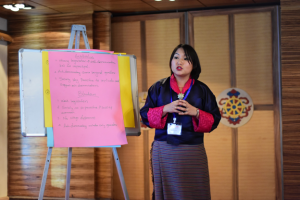
Kesang Om, Manager, Institute for Learning Solutions, discusses gender and social inclusion
The Short Course focused on developing capabilities for the systematic monitoring and evaluation of industry-based training interventions through capacity development and engagement.
The Australia Awards Short Course participants included representatives from Bhutan’s Ministry of Labour and Human Resources, private training institutes and industry organisations from Bhutan.
Throughout the Short Course, participants worked to address the unique challenges facing both Bhutan’s Ministry of Labour and Human Resources, and the country’s training institutes and emerging industry associations.
Each participant developed a RWP with the aim of implementing the plan in their workplaces to incorporate their studies into practical solutions in Bhutan.
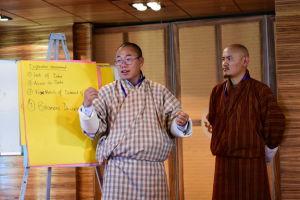
Sonam presenting his RWP to Sector Associations and Stakeholders Panel Discussion
Return to work plan highlights
Participant Pema Namgyel works as a Program Officer for the Association of Bhutanese Industries in Phuentsholing, Bhutan. Pema’s RWP focused on data reporting training to manufacturing industries for greenhouse gas inventory. Following discussion regarding the RWP with the National Environment Commission, the plan was granted funding under the United Nations Environment Program and gained national media attention.
Executive Director of the Association of Bhutan Tour Operators (ABTO), Sonam Dorji, developed a RWP on the Royal Institute of Tourism and Hospitality (RITH) “Diploma in Tourism Management Course — Graduate Tracer Survey”. As RITH is the only institute in Bhutan that offers a diploma in tourism management, Sonam looked to develop an understanding regarding how new skills are applied on the job and establish evidence of the business value of training. The RITH will be using Sonam’s study report for deliberation in their Advisory Board and his survey used to gather further data from course alumni.
Ministry of Labour and Human Resources Chief ICT Officer, Kuenzang Lhadon, developed a RWP for a project attracting praise among Short Course stakeholders and other participants. Her RWP was an employment development program which found that job seekers were more likely to engage in different industries through the influence of friends rather than social media. Kuenzangs’ RWP focused on developing training programs where gaining employment upon completion of training is embedded into the course design.
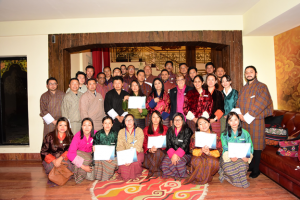
Final group photo with graduation certificates
This Australia Awards Short Course was funded by the Department of Foreign Affairs and Trade (DFAT).
Australia Awards are prestigious international Scholarships, Fellowships and Short Courses that offer the next generation of global leaders an opportunity to undertake short-term study, research and professional development opportunities in support of key development and foreign affairs priorities.
Short Course opportunities build valuable people-to-people links both within Australia and within the Indo-Pacific region, enabling mid-career professionals and emerging leaders to tap into Australian expertise, gaining valuable skills and knowledge.
To find out more about Australia Awards visit Australia Awards.
Griffith graduates Henrik Pettersson and Anna Zhou are gaining international recognition for their fresh take on games design.
Global recognition

Games design graduate Henrik Pettersson
Bachelor of Games Design alumnus Henrik Pettersson recently won the Apple Design Award for his best-selling game, The Gardens Between.
“I spent the past four years of my life designing this game, so it is a thrill to pick up these awards and to see people enjoying it,” he said.
“I admire the genuine love and appreciation Apple has for design and how they talk, share and promote it.
“The judges talked about the intuitive design, accessibility and the dreamlike world that shines through the art.”
‘We wanted to shake up the industry’
The games designer collaborated on the game with Melbourne-based design company, The Voxel Agents. It won Game of the Year at the Australian Game Development Awards and was also recognised by Apple as the year’s Best Mac Game. The Gardens Between has recently made its way onto mobile phone and iPad, opening it up to a wider audience.
“I hope The Gardens Between can be a game where people can experience deep diving gaming-narrative for the first time- I hope it can help expand the medium,” he said.
“We wanted to be disruptors and shake up the industry a little — this was a call out to the industry that it’s time to grow up and start to explore themes that aren’t exclusively for teenage boys.”
‘It was only possible because of my time at Griffith’
Henrik moved halfway around the globe to enrol in the Bachelor of Games Design — relocating from his home in Sweden to study at Griffith Film School.
“The degree was quite new and the fact that it was based at an arts college with a film school meant that we had quite a wide breadth of artistic craft, skills and knowledge,” he said.
“It was only possible to create something like the The Gardens Between because of my time at Griffith — I had that artistic background, which allowed me to communicate better with my team of artists, designers and composers.”
Best of the best
Fellow Griffith Film School graduate Anna Zhou made Develop magazine’s prestigious ’30 under 30′ list, which recognises the region’s best and brightest games designers.
“It was certainly nice to be named on the list,” she said.
“Design positions are hard to come by, so to be working at this level is really rewarding.
“I’m lucky to be doing a job that I’m passionate about, and it’s great knowing that you’ve impacted someone’s life in a good way – I think people’s favourite games bring joy.”
Industry experience opens doors
Anna is currently a senior designer at Defiant Development, making her way up the ranks after scoring an internship with the company during her final year of study at Griffith.

Games design graduate Anna Zhou
During her time with the company, Anna has worked on quest design and character writing across a range of titles, including the bestselling Hand of Fate and Hand of Fate 2.
“I was very lucky to land an internship there in my third year of uni, and it’s definitely the reason I am where I am today,” she said.
“I worked on the original Hand of Fate during my internship, and at the time, I didn’t realise it was going to be a success.
“I was just asked to play test games, but I realised there was a gap in the game, and I ended up designing a character that players seemed to love.”
Diverse voices
Anna was also recently included in the MCV Pacific Women In Games List, which highlights the achievements of women from across the gaming industry.
“Much like in STEM, there are clearly more men working in gaming than women,” she said.
“I think I bring something different to the table and it’s good to have people from different walks of life in the industry.
“I hope anyone out there who feels that they are too young or old or female or minority to succeed in a particular career can see that it’s possible.”
This article was written forThe Conversation by Associate Professor Ernest Foo, Griffith School of Information Communications Technology.
Cryptocurrencies have become a global phenomenon in the past few years. Now Facebook is launching its own cryptocurrency, in association with Visa, MasterCard, Uber and others. The stated aim of Librais to “enable a simple global currency and financial infrastructure that empowers billions of people”.
The announcement has sparked fears that Libra could bea threat to traditional banks, warnings to becautious, andsceptical commentaryof claims that it will help developing countries.
But let’s go back to the basics and look at what Libra is, how it compares to other cryptocurrencies and whether you should be concerned about using it when it eventually arrives.
What is a cryptocurrency?
Currency is a system of money that is commonly used in exchange for goods and services and, as a result, holds value. Cryptocurrencies are digital currencies that are secured using cryptography.
The more popular recent cryptocurrencies are based on blockchain technology which uses a cryptographic structure that is difficult to change. One of the key properties of this structure is a distributed ledger that keeps account of financial transactions, which anyone can access.
What is Libra?
Libra is a new currency that is being proposed by Facebook. It’s considered a cryptocurrency because cryptography will be used to help protect the value of the currency from tampering — such as double spending — and to protect the payment process.
Libra has the potential to become successful because of the backing from theLibra Association, which is made up of large international corporations such as Facebook, Uber and Vodafone. MasterCard and Visa have also thrown their hats in the ring, but no traditional banks are on the list.
What’s different about Libra compared with other cryptocurrencies like Bitcoin?
Cryptocurrencies like Bitcoin and Ethereum are quite egalitarian in nature. That’s because there is no single authority that verifies transactions between parties, so anyone could potentially do it.
To authorise a Bitcoin transaction you would have to prove that you have done the work, known as a “proof of work”. For Bitcoin, the proof of work is to solve a mathematical puzzle. People who successfully solve the puzzle (proving they have done some work), can add transactions to the blockchain distributed ledger and are rewarded with Bitcoins. The process is known as mining.
The good thing about this is that it reduces fraud. Since anyone can potentially mine Bitcoins, it’s harder to collude as you wouldn’t know who the next person to mine a coin would be. And it’s simple to verify that the person is authorised because anyone can check that the puzzle has been solved correctly.
Based on theinitial descriptions of the currency, it sounds like the difference with Libra is that it will verify transactions using a consensus system known as “proof of stake”, or a variation of this method. Under this system, transactions would be authorised by a group of people who have a stake or ownership in the currency.
This makes it easier to predict who the next person to authorise a transaction might be (since there are a relatively small number of authorising group members), and then collude to launder funds without other group members knowing.
Itappearsthe criteria to become a founding member of the Libra Association is to contribute a minimum of US$10 million entrance fee, have a large amount of money in the bank and be able to influence a large number of people.
What are banks and regulators worried about?
Cryptocurrencies affect governments and tax systems since they have little to no transaction costs when money is transferred across borders. So while the low transaction costs would be good for everyday users, the advent of a new cryptocurrency with a potentially very large user base has governments and traditional banks very concerned.
While Libra is open source — meaning the source code is available for all to view, use and modify — it’s the members of the association who will be overseeing the currency. Libra could herald a shift away from traditional government taxes and banking fees to a new international monetary system controlled by corporate entities like Facebook and Uber. That’s a concern because of the lack of oversight from regulatory bodies.
What should everyday people expect from Libra?
The backing of software giants means it’s likely that the user interface for Libra coins would be smooth and simple to use.
Low transaction costs would benefit users and the Libra Association promises to control the value of the currency so that it does not fluctuate as much as other cryptocurrencies. It’s unclear how they plan to do this. But value stability would be a great advantage in times of uncertainty.
What are the risks?
The everyday consumer probably wouldn’t know the difference between the “proof of work” and the “proof of stake” mechanisms. But since Facebook has a large database of users that are known to use Libra, it may be able to link Libra transactions to individuals. This could be a privacy concern. (Bitcoin transactions are anonymous because account numbers used in Bitcoin transactions are not linked to an individual’s identity.)
Recent cybersecuritybreacheshave contributed to a growing awareness of the vulnerabilities of IT systems. As with all software, the Libra implementation and management could be vulnerable to attack, which in turn could mean users could lose their money. But that is a risk that all cryptocurrency users face, whether they are aware of it or not.
What steps could consumers take to protect themselves?
No matter what cryptocurrency you choose to use, your funds are still accessible through the same interfaces: a web page or a mobile app. And the way you control access to your personal funds is by authenticating with a password.
Make sure you keep your password safe by making sure it is complicated and hard to guess. Look for applications that allow you to use two-factor authentication and make sure it’s turned on.
Libra is yet to prove its claims of making financial transactions safe and convenient. Only time will tell if its uptake will become widespread following its expected launch next year.
Griffith University’s reputation as a global leader in business education has been strengthened with news that Griffith Business School’s AACSB International accreditation has been extended for a further five years.
Being accredited by The Association to Advance Collegiate Schools of Business is recognised as the highest standard of excellence in business education and affirms Griffith Business School‘s place among the world’s leading business schools.
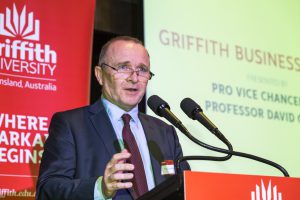 Griffith Pro Vice Chancellor (Business) Professor David Grant said the re-accreditation was an outstanding recognition of the excellent work done by the School over the past several years.
Griffith Pro Vice Chancellor (Business) Professor David Grant said the re-accreditation was an outstanding recognition of the excellent work done by the School over the past several years.
“This reinforces our position as a first–class business educator, solidifying the offering to students and bolstering industry partners’ confidence in Griffith Business School,” he said.
“Fewer than five percent of the world’s business schools have been accredited by AACSB International.
“For this result I am grateful to all our staff members, academic and professional, present and past, to our industry partners and stakeholders, to our students, and to the broader University community for their contributions and support.”
“As part of the final report presented to the AACSB International Board of Directors, the Peer Review Team provided a set of constructive comments and suggestions to help us take advantage of the many opportunities that lie ahead.
“Through this process we have developed new knowledge that will support our further growth and development moving forward.
We will be working towards embedding these suggestions into our strategy for 2020-2023.
“We have been overwhelmed by messages of support and congratulations after sharing this achievement with members of the communities we serve,” Professor Grant said.
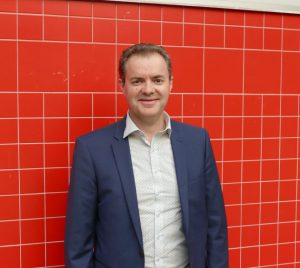 “This is confirmation ofthe remarkable student learning experience students can anticipate throughout their studies at Griffith,” said Paul Hodgson, General Manager Innovation and Stakeholder Engagement with National Energy Resources Australia (NERA).
“This is confirmation ofthe remarkable student learning experience students can anticipate throughout their studies at Griffith,” said Paul Hodgson, General Manager Innovation and Stakeholder Engagement with National Energy Resources Australia (NERA).
Mr Hodgson is a Griffith Business School graduate and current Chair of the School’s Alumni Advisory Group.
“The School is deeply committed to providing a high-quality education with the best possible outcomes for its graduates,” he said.
“It is wonderful to see the School’s continuing efforts recognised in this way.”
Synonymous with the highest standards of excellence since 1916, AACSB provides quality assurance, business education intelligence, and professional development services to over 1,600 member organizations and more than 800 accredited business schools worldwide.
Griffith was only the fifth university in Australia to receive accreditation from AACSB in 2009.
Leaders from across the Indonesian tourism sector traveled to Australia to complete an Australia Awards – Short Term Award in Sustainable Tourism Development with Griffith University and the University of the Sunshine Coast.
(more…)
Industry stakeholders and researchers gathered to commemorate 20 years of Griffith University’s coastal management expertise in protecting and enhancing the Gold Coast’s iconic shoreline.
The Griffith Centre for Coastal Management (GCCM) has played an integral role in building the Gold Coast’s resilient coastal community through targeted research as well as community and stakeholder engagement in the face of extreme weather events, urban pressures and climate change.
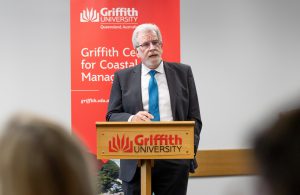
Credit: Luke Marsden
Director Prof Rodger Tomlinson said GCCM had achieved much since its launch in 1999, with thecentrehoused at the Griffith’s Gold Coast campus south of the Smith St Motorway.
“Coastal communities face many challenges, with the greatest being natural hazards such as storms, cyclones and subsequent beach erosion,” he said.
“GCCM has developed a national and international reputation for undertaking targeted research that contributes to all aspects of sustainable management of coastal regions, particularly for urban environments.
“A major focus is on research of relevance to local authorities and the Centre delivers a core program of research in partnership with the City of Gold Coast.”
In 2006, the City of Gold Coast engaged GCCM to develop the Shoreline Management Plan. A strategy with a 50-year horizon, the Plan focuses on coastal physical and ecological processes, economic and community values, and beach management.
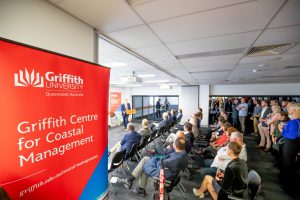
Credit: Luke Marsden
At its heart, the Plan aims to keep sand on thebeachesso the tourists keep coming, and prevent erosion from threatening infrastructure when wild weather arrives.
GCCM also facilitates the Coastal Community Engagement Program in partnership with City of Gold Coast.
While boosting community awareness of coastal management, the Program also gives residents opportunities to care for their local beach environments through planting native dune species, weed removal, litter collection and auditing.
GCCM’s major partners include:
- City of Gold Coast
- Gold Coast Water & Waste
- NSW Department of Industry
- Gold Coast Waterways Authority
- International Coastal Management Pty Ltd
- Sunshine Coast Regional Council
- Noosa Shire Council
- SPEL Environmental
Among GCCM’s community affiliations and committee memberships are:
- Friends ofCurrumbin
- Gold Coast Catchment Association
- World Surfing Reserve (WSR) Local Stewardship Committee (LSC)
- Australian Coastal Society
- Healthy Land and Water
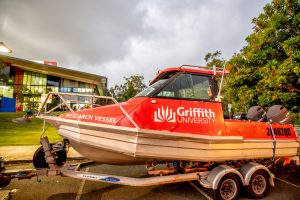
Credit: Luke Marsden
With 80% of Australians living by the coast, Pro-Vice Chancellor Griffith Sciences Professor Andrew Smith highlighted the importance of GCCM’s role in developing adaptation strategies for coastal cities to cope with climate change and extreme weather events.

The ‘Big Bird’ research platform.
“We need to understand how to make our cities and coastal communities better adapted to these threats,” Prof Smith said.
“Gold Coasters may remember that we dodged a bullet earlier this year with Cyclone Omar, which fortunately stayed 700km out to sea but did coincide with the King Tides.
“Ongoing research by GCCM plays an important role in helping to tackle the problems of coastal erosion, inundation and in developing more effective long-term management strategies.
“This helps reduce future costs and brings significant long term social, environmental and economic outcomes.”
In May, GCCM launched ‘Big Bird’, a large yellow research platform off South Stradbroke Island on the Gold Coast, to monitor the impacts of wild weather and climate change. And a new radar installation at the Sea Way measures wavebehaviour, sending back huge amounts of data to be interrogated using Big Data Techniques.
GCCM will also take part in Griffith Sciences’ upcoming discussion panelSea Cities: maintaining the balance between urban expansion and natural opportunities.
Dean and Head of the School of Education and Professional Studies Professor Donna Pendergast has welcomed the results of new research showing teaching jobs will soon buck the trend of shortages with the biggest oversupply of employment opportunities in Australia by 2022.
Analysis by WithYouWithMe has found the education sector is expected to have an oversupply of a 30,242 jobs nationwide by 2022.That means there could be 13.28 per cent more jobs available than teaching graduates that year.
Professor Donna Pendergast said the availabilities would be across the board, in both primary and secondary school, and particularly across the core areas of English, math and science.
She said it was due to population growth and the generational changeover of the workforce.
“We’ve had lots of people who have been teachers for their whole careers and they are moving out of the workforce,” Professor Pendergast said.
“But it’s also a change in the way the teaching workforce is now operating.”
She said graduates were coming into the workforce, staying four or five years and then leaving.
However, Professor Pendergast said people could look positively to the future of teaching.
“The work around understanding the teacher workforce is really just starting to get some teeth about it, so we can look at that with confidence.”
“(The House of Representatives) identified some of the challenges within the profession and what we might do to address those.
“It is absolutely a moment where we can take stock, use all of this kind of information that we have available to us and do some work around innovating in this particular profession.”
Griffith University hosted the Queensland Creating Futures Summit: a focus on the teaching profession on June 18.
It comes as earlier this year, the Federal Government identified education and training as one of Australia’s top four growth industries.
In Queensland, experienced senior teachers earn a base salary of $97,297 p/a, a head of department earns a base salary of $111,540 p/a, and an executive principal earns a base salary of $170,428 p/a.
Griffith’s School of Education and Professional Studies is among the world’s leading education schools, ranked in the top 150 worldwide and has one of the best graduate success rates in Australia.
Griffith has achieved the highest position of any Australian university in the Shanghai Global Ranking of Academic Subjects 2019, having been ranked second globally for Hospitality and Tourism Management.
In an outstanding result, the University was ranked in 37 of the possible 54 subjects with two recognised in the Top five in the world and nine inside in the global Top 100.
The University was also ranked first in Australia for Nursing and Midwifery (fourth in the world) and in Law and Criminology where Griffith rose four spots to number 29.
Griffith Marine/Ocean Engineering was ranked number 13 in the world.
Vice Chancellor and President, Professor Carolyn Evans said the Shanghai ranking results were outstanding.
“I am very pleased to see Griffith continue its upward trajectory on the Shanghai academic subject rankings.” she said.
“Results like these are the outcome of long-term planning and strategic focus by the University combined with the pursuit of excellence by our academic staff.”
 2018 Griffith Nursing and Midwifery graduate Oliver Dupen said his experience at Griffith was incredible.
2018 Griffith Nursing and Midwifery graduate Oliver Dupen said his experience at Griffith was incredible.
“My choice to study there was definitely influenced by its global recognition and ranking as the best university in Australia for Nursing,” he said.
“I think the climb in rank comes as no surprise when I reflect on the calibre of teachers I encountered during my course.
“Griffith has an incredible staff of both academics and clinicians that enabled me to excel in both my clinical knowledge and patient care.”
Oliver is currently working as a Registered Nurse in the Cardiology ward at Gold Coast University Hospital.
 Bachelor of Laws / Bachelor of Criminology and Criminal Justice student Hannah Wallace said knowing Griffith Law was ranked first in the country and 29th in the world was a confidence boost for her and fantastic recognition for the university.
Bachelor of Laws / Bachelor of Criminology and Criminal Justice student Hannah Wallace said knowing Griffith Law was ranked first in the country and 29th in the world was a confidence boost for her and fantastic recognition for the university.
“It is such a great boost of confidence for us that as a young university we’re being recognised in a global setting so early on,” she said.
“I think that Griffith’s reputation as being such a practical university with a particular focus on social justice and global perspective is a draw card for students who want to gain a comprehensive understanding of important issues on a national and international scale and be able to make a meaningful difference regarding these fundamental issues.”
“I’ve been a student ambassador for three years and I have noticed that now at student expos we are inundated with enquiries about Law where we weren’t before … because people are starting to hear about our growing reputation.”
Hannah’s dream job is to work as a prosecutor with the UN or a human rights lawyer, so global recognition of her studies will be incredibly valuable.
It comes as Griffith moves up two places to 35th in the Times Higher Education (THE) Young Universities listing released today.
“This is another great result for the university,” said Professor Evans.
“These ranking results demonstrate the breadth and excellence of scholarship at Griffith and signal that the University is poised to make further substantial progress in coming years.”












 “This is confirmation ofthe remarkable student learning experience students can anticipate throughout their studies at Griffith,” said Paul Hodgson, General Manager Innovation and Stakeholder Engagement with National Energy Resources Australia (NERA).
“This is confirmation ofthe remarkable student learning experience students can anticipate throughout their studies at Griffith,” said Paul Hodgson, General Manager Innovation and Stakeholder Engagement with National Energy Resources Australia (NERA).



 2018 Griffith Nursing and Midwifery graduate Oliver Dupen said his experience at Griffith was incredible.
2018 Griffith Nursing and Midwifery graduate Oliver Dupen said his experience at Griffith was incredible. Bachelor of Laws / Bachelor of Criminology and Criminal Justice student Hannah Wallace said knowing Griffith Law was ranked first in the country and 29th in the world was a confidence boost for her and fantastic recognition for the university.
Bachelor of Laws / Bachelor of Criminology and Criminal Justice student Hannah Wallace said knowing Griffith Law was ranked first in the country and 29th in the world was a confidence boost for her and fantastic recognition for the university.